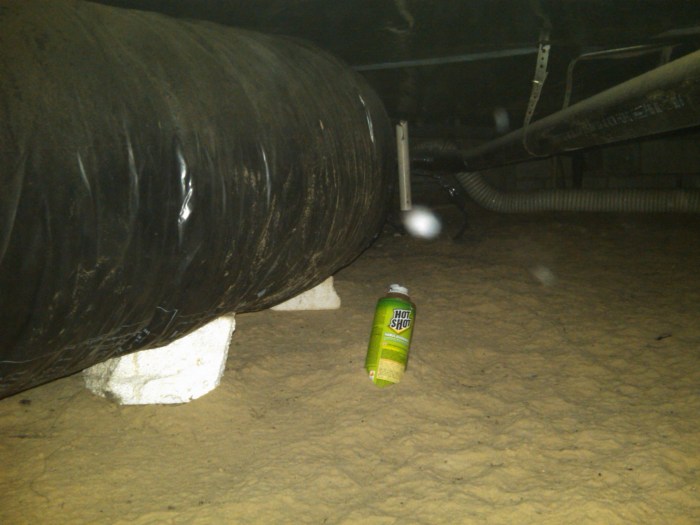Bug bombs are a powerful tool for eliminating pests in crawl spaces, but using them safely and effectively requires careful preparation. This guide will provide a step-by-step walkthrough of bug bomb crawl space preparation, selection, deployment, and post-treatment cleanup, ensuring a successful pest control experience.
Before setting off a bug bomb in a crawl space, it is crucial to take necessary safety precautions to minimize risks to health and property. Sealing off the crawl space from the rest of the house, protecting personal belongings from fumes, and following manufacturer’s instructions are essential steps for a safe and effective treatment.
Bug Bomb Crawl Space Preparation

Before setting off a bug bomb in a crawl space, it is crucial to take safety precautions. These include:
- Wearing a respirator or dust mask to avoid inhaling harmful fumes.
- Turning off all pilot lights and gas appliances to prevent explosions.
- Removing all pets, children, and other occupants from the house.
To seal off the crawl space from the rest of the house, follow these steps:
- Seal any cracks or holes in the foundation with caulk or expanding foam.
- Cover all vents and openings with duct tape.
- Hang plastic sheeting over the crawl space entrance and seal it with duct tape.
To protect personal belongings from the fumes, consider the following:
- Move all valuables, electronics, and food items out of the crawl space.
- Cover any remaining items with plastic sheeting or tarps.
- Place a fan at the entrance of the crawl space to circulate air and help remove fumes.
Bug Bomb Selection and Placement: Bug Bomb Crawl Space

Bug bombs come in various types, including foggers, aerosols, and dusts. Foggers release a fine mist that penetrates deep into crevices and corners. Aerosols are more concentrated and can be sprayed directly onto surfaces. Dusts are ideal for treating small areas or cracks and crevices.
To calculate the number of bug bombs needed for the size of the crawl space, follow the manufacturer’s instructions. Generally, one bug bomb is sufficient for every 1,000 cubic feet of space.
Place the bug bombs evenly throughout the crawl space, ensuring they are at least 10 feet apart. Avoid placing them directly on insulation or other flammable materials.
Bug Bomb Deployment and Timing
To safely set off a bug bomb, follow these steps:
- Read and follow the manufacturer’s instructions carefully.
- Activate the bug bomb in the center of the crawl space.
- Immediately leave the crawl space and seal the entrance.
It is crucial to leave the bug bombs in the crawl space for the recommended amount of time, typically 2-4 hours. This ensures that the fumes have enough time to kill all pests.
Post-Treatment Ventilation and Cleanup
After the bug bombs have been deployed, it is essential to ventilate the crawl space thoroughly.
- Open all windows and doors to allow fresh air to circulate.
- Use a fan to help remove fumes.
- Ventilate the crawl space for at least 24 hours before re-entering.
Once the crawl space has been ventilated, clean up any dead insects and debris. Use a vacuum cleaner to remove dust and particles. If there is a lot of debris, consider using a shop vac.
To prevent future infestations, keep the crawl space clean and dry. Remove any sources of food or water that could attract pests.
Alternative Pest Control Methods

In addition to bug bombs, there are other methods of pest control that can be used in crawl spaces:
- Traps:Glue traps, snap traps, and bait stations can be effective in catching rodents and insects.
- Baits:Rodenticide and insecticide baits can be placed in areas where pests are likely to feed.
- Exclusion:Sealing cracks and holes in the foundation and around pipes can prevent pests from entering the crawl space.
The best pest control method for a particular crawl space will depend on the type of pests present and the severity of the infestation.
Safety Considerations for Pets and Children

Bug bombs can be harmful to pets and children if they are exposed to the fumes.
- Keep pets and children out of the crawl space during and after treatment.
- Ventilate the crawl space thoroughly before allowing pets or children to re-enter.
- If any adverse reactions occur, such as difficulty breathing, dizziness, or skin irritation, seek medical attention immediately.
Answers to Common Questions
How long should bug bombs be left in a crawl space?
The recommended duration varies depending on the size of the crawl space and the type of bug bomb used. Generally, it is advised to leave the bombs for 6-12 hours.
Can I use multiple bug bombs in a crawl space?
Yes, using multiple bug bombs may be necessary for larger crawl spaces. Calculate the number of bombs needed based on the manufacturer’s instructions and the size of the area.
What are some alternative pest control methods for crawl spaces?
Alternative methods include insect traps, bait stations, and professional pest control services. The best method depends on the type of pest infestation and the severity of the problem.
